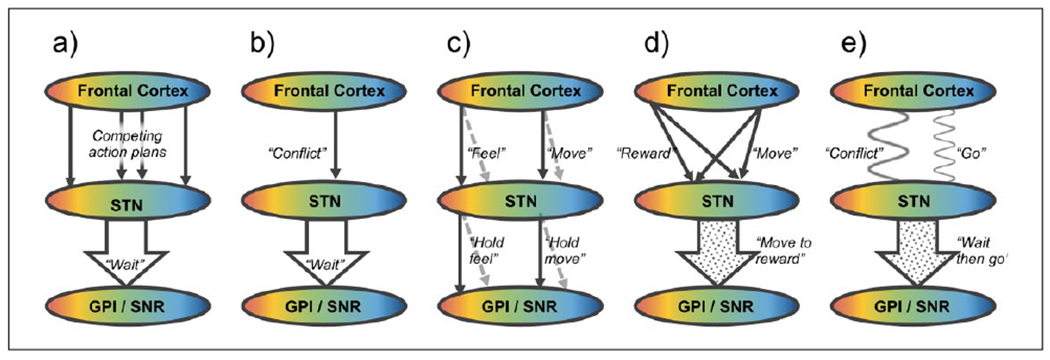Figure 6.

Action control in the STN. Simplified scheme of possible conceptual routes of information flow between the frontal cortex, STN, and GPI/SNR, based on functional anatomical or dynamic connections. Color gradients represent topographical organization of functions from the blue “motor” part in the most posterior dorsolateral STN to the red “limbic” part in the most anterior ventromedial STN, with connected areas in the frontal cortex and GPI/SNR (Alexander and others 1990, Haynes and Haber 2013). Similar principles could be relevant for the striato-pallido-subthalamic (indirect) pathway, but the figure does not address how this input is integrated with cortical input in the STN. All of these schemes may be relevant, in parallel or depending on context. (a) Competing input model: Competing action plans reaching the STN cause a global excitation of GPI/SNR, conveying a “wait” signal to withhold a response until the optimal action is selected by the striatum (Bogacz and Gurney 2007; Frank 2006). (b) Specific input model: A specific signal from the PFC to the STN (conveying for example “Stop” or “Conflict”) causes global excitation of GPI/SNR (Aron and others 2016). (c) Parallel/spiral model: Parallel circuits in the basal ganglia loop process different types of information, though the inhibitory effect of STN on basal ganglia output may be similar regardless of information type (Alexander and others 1986). Open and closed loops across the basal ganglia may allow information to spiral from ventral to dorsal loops (Haber 2003; Haynes and Haber 2013; Kelly and Strick 2004). (d) Integration model: Integration of information modalities to specific neurons across the STN (Espinosa-Parrilla and others 2013; Janssen and others 2017). This could be anatomically supported by nucleus-wide dendrites (Sato and others 2000), intranuclear axon collaterals (Kita and others 1983) or STN-Gpe interactions. STN neurons convey a specific but integrated (modular) signal to the GPI/SNR. (e) Dynamic model: The frontal cortex conveys different signals to the STN through directed oscillatory coupling. For example, a “conflict” signal from the PFC can be transmitted through increased theta coherence, and a “go” signal from sensorimotor cortex can be transmitted through decreased beta coherence. In the STN, parts of the local processing by neurons and high-frequency oscillations can entrain to these rhythms, and the participating ensemble of neurons transmits a collective but patterned signal to the GPI/SNR (Aron and others 2016; Brittain and others 2014; Zavala and others 2015; Zavala and others 2017a).
